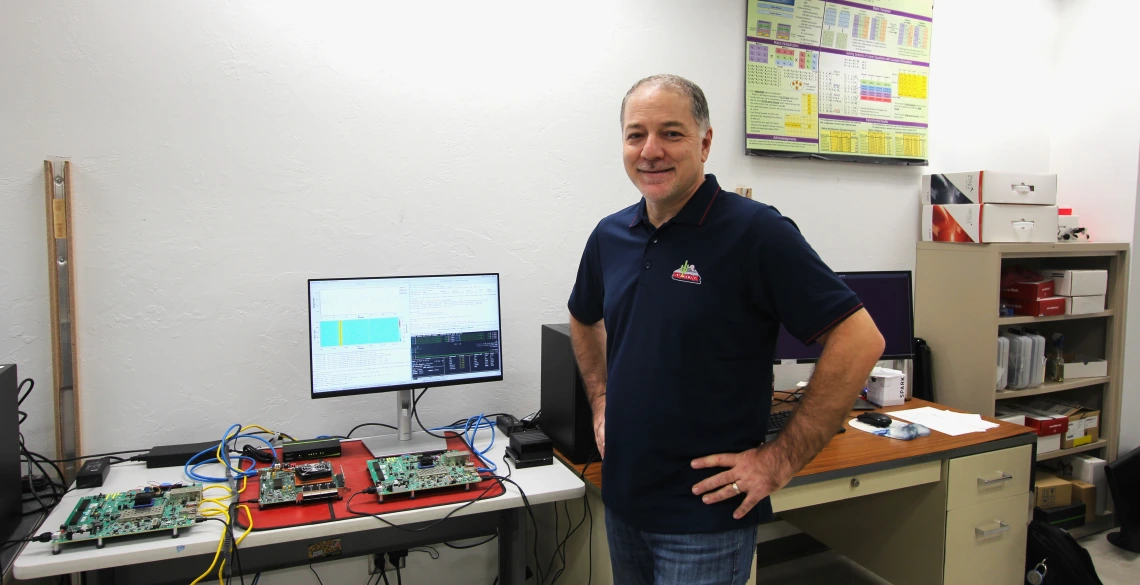Creating a Common Language for Satellites
DARPA selects a team of Arizona researchers to advance communication abilities between groups of satellites in low-Earth orbit.

No description provided
Dozens of satellite constellations are orbiting the Earth, providing capabilities such as GPS, internet, satellite radio and communications. They each use their own algorithms and programming languages to communicate with other satellites inside the same constellation.
A multi-university team of Arizona researchers is developing technologies that will enable different satellite constellations to communicate with each other. The Defense Advanced Research Projects Agency, or DARPA, has selected 11 groups for its Space-Based Adaptive Communications Node, or Space-BACN, program. This team, led by Daniel Bliss at Arizona State University, is the only academic group; the remainder are commercial companies. In tandem, the researchers launched a startup company that received $250,000 in support through the DARPA Embedded Entrepreneurship Initiative.
Ali Akoglu, professor of electrical and computer engineering and the BIO5 Institute, leads the University of Arizona portion of the grant, which is about $850,000.
“These satellites are all doing some form of sensing and detection, and if you want to make a collective decision about the situation, you need to be able to fuse together all the data and then process it,” Akoglu said. “It could be different satellites built by different entities and they use only certain communication protocols. Now how can we enable them to talk to each other?”
Advancing a Reconfigurable Chip
This project builds off an earlier DARPA initiative led by the same team, which worked on developing a domain-focused advanced software-reconfigurable heterogeneous system on a chip, or DASH-SoC. It can be time- and resource-intensive for computer scientists to adapt software algorithms to work on specific types of hardware. So, DASH-SoC focused on automating that process, allowing users ranging from academics to industry experts to people like radio hobbyists to quickly program a device even if they don’t know what’s “under the hood.”
“We come into the picture to bridge the gap between the domain expert and the high-performance architecture they’re interested in,” Akoglu said.
These reconfigurable chips have many applications, but this effort will focus on adapting the technology for space, which comes with plenty of challenges. For instance, computers operate using strands of 0s and 1s, and in an occurrence called a bit flip, a piece of information changes from 0 to 1, or vice versa, making it incorrect. Space radiation is one cause of bit flips, which can spell big trouble for these systems.
“Imagine the bit flip occurs on the brain of the system doing the resource management, determining which tasks should run when, and in which order,” Akoglu said. “What if one bit of information, indicating either 0 or 1, that an accelerator is available or not, gets flipped? Your resource management will go out of control.”
Akoglu and his team are focused on the resource management element of the system. They will examine what strategies will best allow the system to work under power restraints and with limited resources.
Launching a Startup
Akoglu and his collaborators at other Arizona universities are also developing a new startup company, Dash Tech Integrated Circuits. The research team collaborated with Tech Launch Arizona, the university office in charge of commercialization, to obtain two patents related to this work. While there are some platforms on the market that do the work of mapping some software to hardware, this is the first platform to offer so much flexibility.
Akoglu looks forward to the technology helping colleagues in computer science and in several areas of engineering, from mechanical engineers working in fluid dynamics to biosystems and agricultural engineers monitoring crop health.
“If this is successful, it can be applied to multiple domains: autonomous vehicles, drones, smart health, any communication system, 5G,” Akoglu said. “I could tell domain experts, ‘You can focus on the theory. We have the ability to take your algorithm and run it efficiently and accurately on any platform that is suitable for your environment.’”


